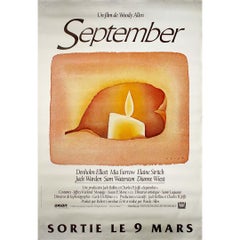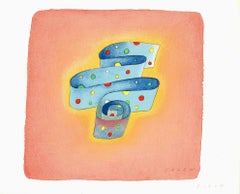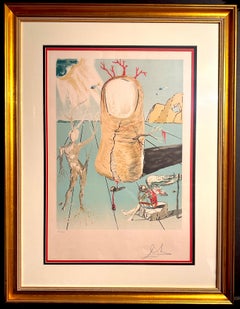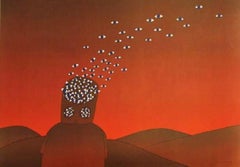Jean-Michel Folon More Prints
Belgian, b. 1934
Jean-Michel Folon (1934 – 2005), better known as “Folon,” was a Belgian painter, illustrator, and sculptor who produced images featured in various publications throughout the world. He is renowned for his branded watercolor illustrations of often whimsical birds, winged people, and other peculiar characters painted in a surrealistic style. Early in his career Folon published his drawings in newspapers mostly in the USA, where he was recognized earlier than in Europe, and illustrated books by Franz Kafka and Ray Bradbury, amongst others. He created numerous works in many different media for well known individuals and cultural institutions worldwide, including in theatre, opera, subways, film and television, sculptures, tapestries, church windows and even a flag.to
1
1
Overall Width
to
Overall Height
to
1
17
688
450
201
159
2
2
1
1
1
1
1
1
Artist: Jean-Michel Folon
1987 Original French movie poster by Jean-Michel Folon for September Woody Allen
By Jean-Michel Folon
Located in PARIS, FR
This elegant original French movie poster was created in 1987 for the release of September, a film written and directed by Woody Allen. The poster features the refined and poetic art...
Category
1980s Jean-Michel Folon More Prints
Materials
Paper
1988 Flag Series - United Nations, Surrealist Lithograph by Jean-Michel Folon
By Jean-Michel Folon
Located in Long Island City, NY
Artist: Jean-Michel Folon, Belgian (1934 - 2005)
Title: 1988 Flag Series - United Nations
Year: 1988
Medium: Lithograph on Arches, signed and numbered in pencil
Edition: 500
Size: 8....
Category
1980s Surrealist Jean-Michel Folon More Prints
Materials
Lithograph
Related Items
Flowers by Andy Warhol (1964) Art Print – Iconic Pop Art Design
By (after) Andy Warhol
Located in Winterswijk, NL
A bold and vibrant reproduction of Andy Warhol’s iconic 1964 Flowers series, this striking artwork is printed on heavy art paper, showcasing the enduring brilliance of Pop Art. The c...
Category
1960s Pop Art Jean-Michel Folon More Prints
Materials
Paper
$152
H 38.19 in W 38.19 in
The Vision of The Angel of Cap Creus - The Thumb
By Salvador Dalí
Located in Hollywood, FL
ARTIST: Salvador Dali
TITLE: The Vision of The Angel of Cap Creus - The Thumb
MEDIUM: Lithograph
SIGNED: Hand Signed
PUBLISHER: Levine & Levine for DALART
EDITION NUMBER: 216/350
MEASUREMENTS: 21.2" x 29.9"
YEAR: 1980
FRAMED: Yes, museum quality gold frame...
Category
1980s Surrealist Jean-Michel Folon More Prints
Materials
Lithograph
Vitraux in Four Sheets Royal Insect
By Salvador Dalí
Located in Hollywood, FL
ARTIST: Salvador Dali
TITLE: Vitraux in Four Sheets Royal Insect
MEDIUM: 4 Lithographs
SIGNED: 1 Lithograph is Hand Signed by Salvador Dali
EDITION NUMBER: 1 lithograph is numbe...
Category
1970s Surrealist Jean-Michel Folon More Prints
Materials
Lithograph
Ivanhoe The Overseer
By Salvador Dalí
Located in Hollywood, FL
ARTIST: Salvador Dali
TITLE: Ivanhoe The Overseer
MEDIUM: Lithograph
SIGNED: Hand Signed by Salvador Dali
PUBLISHER: Levine & Levine
EDITION NUMBER: HC XLIV/LXV
MEASUREMENTS: 2...
Category
1970s Surrealist Jean-Michel Folon More Prints
Materials
Lithograph
Currier & Ives New York Central Park Winter
By Salvador Dalí
Located in Hollywood, FL
ARTIST: Salvador Dali
TITLE: Currier & Ives New York Central Park Winter
MEDIUM: Lithograph + Collage
SIGNED: Hand Signed
PUBLISHER: Phyllis Lucas, New York
EDITION NUMBER: 13...
Category
1970s Surrealist Jean-Michel Folon More Prints
Materials
Lithograph
Marc Chagall - Hommage à Julien Cain - Original Lithograph
By Marc Chagall
Located in Collonge Bellerive, Geneve, CH
Marc Chagall - Original Lithograph
Frontispiece for André Dunoyer de Segonzac, and Julien Cain. "Humanisme Actif: Mélanges d'Art et de Littérature Offerts à Julien Cain." Paris: H...
Category
1960s Surrealist Jean-Michel Folon More Prints
Materials
Lithograph
$1,703
H 7.09 in W 9.26 in D 0.04 in
Engraving #1 by Ernst Fuchs: KABBALAH (SEFER YETSIRA and 32 PATHS OF WISDOM)
By Ernst Fuchs
Located in Cliffside Park, NJ
Original engraving #7 by Ernst FUCHS from Kabbalah (THIRTY-TWO PATHS OF WISDOM by SEFER YETZIRA), 1978
Etching signed and numbered 16/30 E.A.
Page size - 30 ...
Category
1970s Modern Jean-Michel Folon More Prints
Materials
Paper, Etching
Wealth Health Fame and Love
By Salvador Dalí
Located in Hollywood, FL
ARTIST: Salvador Dali
TITLE: Wealth Health Fame and Love
MEDIUM: Lithograph on Japon Paper
SIGNED: Hand Signed
PUBLISHER: Levine & Levine for Collectors Guild/Center Art
EDITIO...
Category
1970s Surrealist Jean-Michel Folon More Prints
Materials
Lithograph
Lyle Stuart Tarot Prints Wheel of Fortune
By Salvador Dalí
Located in Hollywood, FL
ARTIST: Salvador Dali
TITLE: Lyle Stuart Tarot Prints Wheel of Fortune
MEDIUM: Lithograph
SIGNED: Hand Signed by Salvador Dali
EDITION NUMBER: 100/250
MEASUREMENTS: 22.87" x 17...
Category
1970s Surrealist Jean-Michel Folon More Prints
Materials
Lithograph
French Workshop Plans
Located in Houston, TX
Detailed antique lithograph of plans to a brick French workshop, 1881.
Original artwork on paper displayed on a white mat with a gold border. Archival plastic sleeve and Certificate...
Category
19th Century Jean-Michel Folon More Prints
Materials
Ink, Paper
Map of Americas
Located in Houston, TX
Over 200 year old engraved map of Americas by Robert de Vaugondy from 1783. Original hand color. Shows North, Central and South Americas. Note the po...
Category
1780s Jean-Michel Folon More Prints
Materials
Ink, Watercolor, Handmade Paper
Ancient World Map
Located in Houston, TX
Over 150 year old engraved map of the world as it was known during the antiquities by cartographer Delamarche from 1838. Original hand color. Shows African, European and Asian cont...
Category
1830s Jean-Michel Folon More Prints
Materials
Ink, Watercolor, Handmade Paper
Previously Available Items
"The Sight" Offset Print-Published by Nouvelles Images Editeurs, France
By Jean-Michel Folon
Located in Chesterfield, MI
"The Sight" is an Offset Print by JEAN-MICHEL FOLON (Belgian, 1934-2005). It measures 25.75 x 36 inches, is unframed and plate-signed by the artist. Its date of creation is 1970. Copyright Alice Editions. Published by Nouvelles Images...
Category
1970s Jean-Michel Folon More Prints
Materials
Offset
Al Lavoro, Aquatint Etching by Jean-Michel Folon
By Jean-Michel Folon
Located in Long Island City, NY
Artist: Jean-Michel Folon, Belgian (1934 - 2005)
Title: Al Lavoro
Medium: Etching, signed and numbered in pencil
Edition: EA VI/X
Image Size: 6.5 x 5.25 inches
Size: 10.75 x 8.25 in...
Category
1980s Surrealist Jean-Michel Folon More Prints
Materials
Etching
Jean-michel Folon more prints for sale on 1stDibs.
Find a wide variety of authentic Jean-Michel Folon more prints available for sale on 1stDibs. You can also browse by medium to find art by Jean-Michel Folon in lithograph and more. Much of the original work by this artist or collective was created during the 1980s and is mostly associated with the Surrealist style. Not every interior allows for large Jean-Michel Folon more prints, so small editions measuring 12 inches across are available. Customers who are interested in this artist might also find the work of Anatole Krasnyansky, Hans Bellmer, and André Masson. Jean-Michel Folon more prints prices can differ depending upon medium, time period and other attributes. On 1stDibs, the price for these items starts at $1,150 and tops out at $1,150, while the average work can sell for $1,150.
Artists Similar to Jean-Michel Folon
Questions About Jean-Michel Folon More Prints
- 1stDibs ExpertApril 5, 2022You can see Jean-Michel Basquiat paintings in a number of locations. Some of his work is in the collections of the Museum of Contemporary Art in Los Angeles, California, and The Museum of Modern Art in New York, New York. On 1stDibs, find a selection of Jean-Michel Basquiat.
- 1stDibs ExpertApril 5, 2022The meaning of Jean-Michel Basquiat's art varied from piece to piece. Generally, the American artist attempted to illustrate dichotomies, such as the experience of the wealthy versus the experience of the poor and the inner self versus the outer self. On 1stDibs, shop a range of Jean-Michel Basquiat art.



